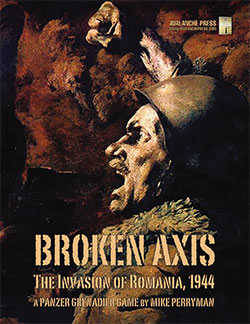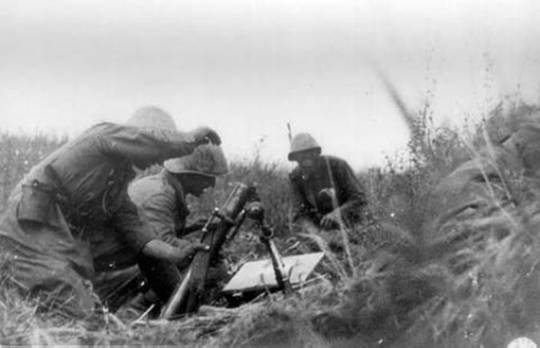Broken Axis:
Second Battle of Târgu Frumos
by Mike Bennighof, Ph.D.
January 2022
 Note: The Second Battle of Târgu Frumos represents the largest “battle game” in our Panzer Grenadier: Broken Axis game, a series of scenarios (in this case 15 of them) that you can play individually just like those in any other Panzer Grenadier game, or together. Note: The Second Battle of Târgu Frumos represents the largest “battle game” in our Panzer Grenadier: Broken Axis game, a series of scenarios (in this case 15 of them) that you can play individually just like those in any other Panzer Grenadier game, or together.
Having failed in his first attempt to seize Târgu Frumos, Marshal of the Soviet Union Ivan Konev determined that his Second Ukrainian Front would try again. On the Axis side, German and Romanian intelligence detected the renewed buildup – for the first time since 1941 operations were taking place on Romanian soil, and local residents provided a steady stream of information.
For his part, Konev knew that the Axis knew that he was up to something. So he purposely held the armies intended to carry out the assault on Târgu Frumos north of Jassy instead. This made perfect sense, since Jassy remained the operational objective for Second Ukrainian Front. To help build the illusion of a direct drive on Jassy, the Soviet 27th and 52nd Armies made limited attacks north of the city, as though they sought to obtain good positions for the upcoming major offensive.

Improvised Soviet anti-aircraft defense.
The mixed German-Romanian Army Group Wöhler, meanwhile, conducted a series of attacks of their own, some north of Jassy intended as spoiling attacks to disrupt the coming offensive, and others as diversions to draw Soviet reserves away from Jassy. These latter operations included, ironically enough, attacks in front of Târgu Frumos – exactly the sector to which the Soviets wished to move.
Konev’s armies still had not received adequate replacements for their tank losses over the previous months, and would go into battle severely understrength. Post-war Soviet histories minimized the importance of the battles in Bessarabia, and the lack of fresh tank deliveries lends credence to that position. What reinforcements they did receive included the new heavy Josef Stalin tanks, so neither was Konev starved of resources.
Col. Gen. Otto Wöhler and his staff expected the Soviets to attack on May 1st, International Workers’ Day, but the most important holiday on the Soviet calendar passed relatively uneventfully. Konev had hoped to attack on that propitious date, but the spoiling attacks had done their job and the Soviets were not ready. The assault opened a day later, with four armies in action: on the Soviet right, 7th Guards Army would make the initial penetration, with 5th Guards Tank Army following up to exploit the breakthrough. On the Soviet left, it would be 27th Army’s rifle divisions in the first echelon, followed by 2nd Tank Army. Fifth Guards Tank Army fielded 358 tanks and assault guns, about half its authorized strength, with 2nd Tank Army totaled only 121.

Romanian Royal Guards fire a 60mm mortar.
Wöhler’s three best formations faced the attackers at Târgu Frumos. On the left stood the Romanian Royal Guard (misidentified as the 1st Royal Romania Mare Armored Division in the only English-language work on the battle, and credited with 80 non-existent tanks). The Guard fought well throughout the April fighting until the very last days of the preliminary spoiling attacks, when some rifle companies suffered battlefield panic. In the center, Panzer Grenadier Grossdeutschland placed its two motorized infantry regiments in the front line with its panzer regiment in reserve to be used as a single powerful counter-attacking force rather than parceled out in small groups. To the right of Grossdeutschland, the much weaker 24th Panzer Division had only a handful of tanks and assault guns to its name and had shown itself to be less efficient than Grossdeutschland or the Royal Guard.
The Soviet assault, when it came, owed more to the Great War than the Great Patriotic War. Konev hoped to make up for his shortage of tanks with a massive artillery barrage. After a heavy rolling bombardment lasting more than an hour, the infantry went forward at about 0530 accompanied by the heavy “breakthrough” tanks with salvoes of rockets whizzing overhead.
According to German accounts, the Romanian Royal Guard fled the battlefield while Grossdeutschland troops fought fiercely to repel the attacks but were overwhelmed by sheer numbers. According to the Romanians, it was the other way around. In any event, the Soviets made impressive headway, surging into the Axis rear areas but leaving a number of isolated strongpoints behind them.
And then the Panzer Lion sprang into action.
Personally leading his panzer regiment, Hasso von Manteuffel of Grossdeutschland – known to his men as the “Panzer Lion” - first headed west to crush the attacking 81st Guards Rifle Division, breaking their attack by 0900. While his tanks drove the attackers back and beyond their start line, the Soviet 35th Guards Rifle Corps had found the junction of Grossdeutschland’s two motorized infantry regiments and punched through, followed promptly by 3rd Guards Tank Corps. The Panzer Lion drove his tanks and men back to the east where they fell on the exploiting Soviets just before noon, shooting up 30 tanks in a few minutes. Fighting continued for the remainder of the day, but the Germans had restored their positions.
To the east of Grossdeutschland, Maximilian von Edelsheim’s 24th Panzer Division had likewise planned to use its much more limited armored strength to counter-attack enemy breakthroughs. Edelsheim’s division proved too weak to achieve this on its own, but with the help of Manteuffel’s panzers it also managed to seal off the Soviet advance.

Per Marshal Konev’s orders, Soviet assault troops concentrate on a narrow front.
On the following day, Konev directed his armies to concentrate their forces on narrow fronts to achieve and hold breakthroughs. The Axis reshuffled their forces as well, bringing a grenadier battalion from 24th Panzer Division to plug the gap between Grossdeutschland’s two infantry regiments and stationing much of the Grossdeutschland armor close to the front to act in an anti-tank role.
This time, the attack went nowhere. Fifth Guards Tank Army had lost half of its armor on the previous day, and now lost half of its remaining tanks. Supporting attacks on both flanks against Romanian and German infantry divisions also failed to make any headway. Second Tank Army also failed to make much progress, but suffered far fewer losses of tanks.
Despite the continuing loss of combat power, Konev decided to make one more attempt. To compensate for the lost armor, a very heavy artillery barrage would precede the assault. This time the attackers had even less success than one the 3rd, and as daylight faded Konev called off the offensive. The Marshal reported to Stavka that these attacks had only been intended to disrupt the Germans’ ability to launch a counter-attack of their own, and therefore were successful.
Even in Konev’s re-written history, however, the third day represented an utter failure. The Axis began a series of attacks on May 5th intended to re-establish their original positions, and steadily drove the Soviets back. But even so, the Germans had lost a great deal of their own offensive potential – Manteuffel had even been forced to disband one of his motorized infantry battalions due to losses – and their attacks had only limited success.
Afterwards, Konev blamed his subordinate army and corps commanders for the failure; since Stavka simply ignored his demands that they be disciplined or fired it appears that the General Staff had a different opinion but did not consider the setback worthy of a move against one of the Great Stalin’s favorite commanders. Second Ukrainian Front took up defensive positions and prepared for a renewed offensive in late summer.
The Germans declared that they had repelled a major Soviet offensive, which exaggerates the scale of the Soviet effort. However, the Germans had performed exceedingly well, particularly the Grossdeutschland division. In 1948, Manteuffel delivered a lecture about Târgu Frumos to the U.S. Army War College in which he modestly declared the battle to be a “classic example of mobile defense.” His lecture notes, and the tactical exercises derived from them, would be the basis for many further studies at Leavenworth over the decades that followed.
You can order Broken Axis right here.
Sign up for our newsletter right here. Your info will never be sold or transferred; we'll just use it to update you on new games and new offers.
Mike Bennighof is president of Avalanche Press and holds a doctorate in history from Emory University. A Fulbright Scholar and NASA Journalist in Space finalist, he has published an unknowable number of books, games and articles on historical subjects.
He lives in Birmingham, Alabama with his wife, three children and his new puppy. He will never forget his dog, Leopold.
Want to keep Daily Content free of third-party ads? You can send us some love (and cash) through this link right here.
|
